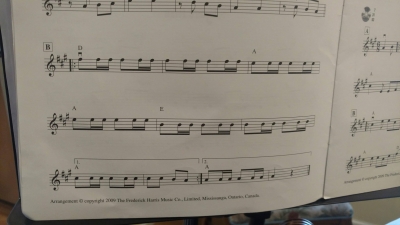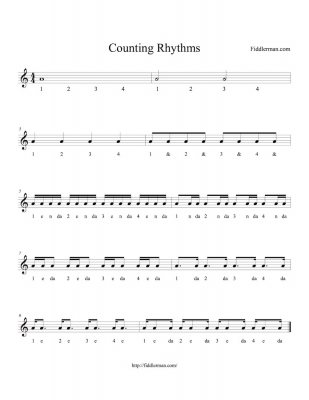Welcome to our forum. A Message To Our New and Prospective Members . Check out our Forum Rules. Lets keep this forum an enjoyable place to visit.
Currently working on errors from the latest (SimplePress) forum update. Many issues have been resoled and others are being worked on. Thank you for your patience.
 Topic RSS
Topic RSS



 (0 votes)
(0 votes) Regulars
 Offline
Offline

Ok I'm working on slowly learning harder songs and this is in my book and it's a rendition of "rubber dolly" This is the B portion but I have absolutely no idea how to play this haha. Is this double stops? or a regular note with two bow changes? It's probably staring me right in the face but after trying several ways to play this it just doesn't feel right at all so I figured I'd reach out here 😀
Lead me, Follow me, or get out of my way!
~General George S. Patton
Member
 Offline
OfflineIf you mean you aren’t understanding how to play the rhythm of those notes, the way I learned them is that they are counted like “1 and a, 2 and a” for each measure. (Or however many beats there are in the measure..) Off the top of my head I can’t remember what the notes are called, but basically It is counted as an eighth note followed by two sixteenth notes.
If you aren’t understanding the end, you play the section through until you get to the measures that are underneath brackets 1 and 2. You play through bracket 1, then go back to the beginning of the section and play it again. When you get to the brackets a second time, then you play through bracket two as the ending.
I’m not really the greatest at explaining things, but I hope I was some help!
Regulars
 Offline
Offline




That's an eight note followed by two 16th notes repeating it's call the Nashville shuffle or the double shuffle, think long, short, short, long, short, short, long, short, short repeating.
Go to bluegrass Daddy .com and look up under lessons Rubber Dolly and listen to him play it that may help.
Mark
Master the Frog and you have mastered the bow.
Albert Sammons
Advanced member
 Offline
OfflineIf you're talking about the double barred notes, those are 16ths. So the rhythm is 8th-16th-16, 8th-16th-16th. There are four 16th notes in one quarter note, so you can count it as one-ee-and-ah, being sure that all four 16ths take the same time as a single quarter note. A 16th gets half the count an 8th note does. So in this case, instead of counting one-and two-and, you would count one-ee for the 8th note and then and-ah for the next two 16th notes. That sounded a little confusing to me writing it out, but let me know if it helps. Essentially, they're just shorter notes that get half the count of an 8th note and one fourth the count of a quarter note.
Edit: dang, you guys are on it. Thought I was first :p
Regulars
 Offline
Offline




It's like spirryn said 🙂
So those aren't double-stops, they're simply 16th notes. I cannot see the time signature, but I'm guessing it's 2/4, since if you add up the note lengths you will get 2 quarter notes within one measure.
Basically they're like 8th notes, but have half the duration and they have a double flag, which are linked together creating that 'double line'...
Regulars
 Offline
Offline

1 Guest(s)


 Log In
Log In Register
Register






















